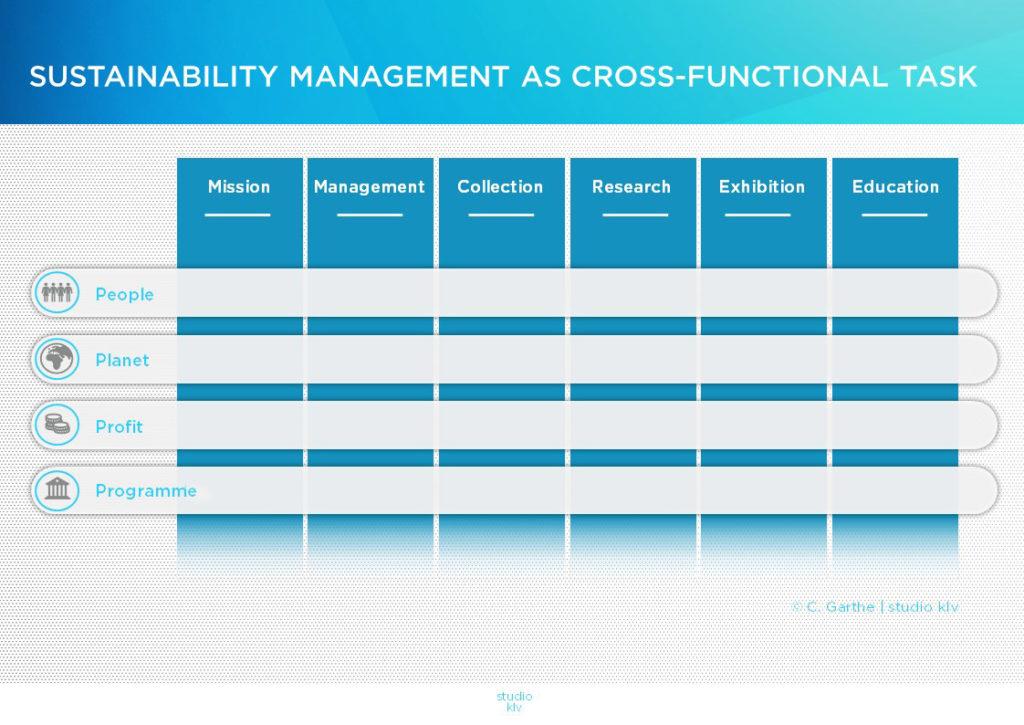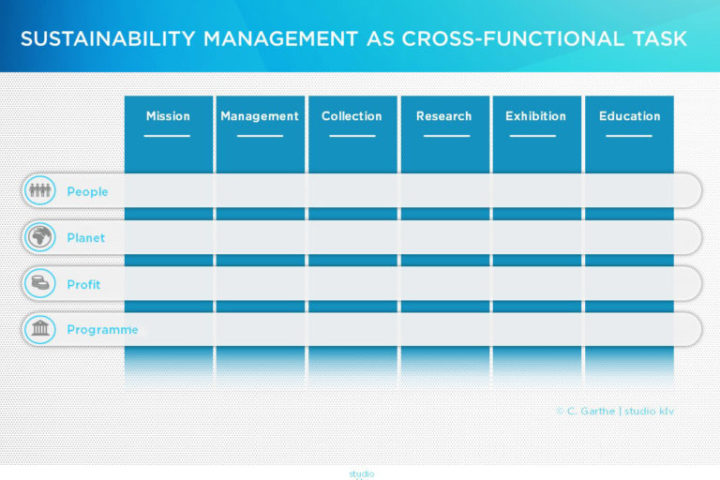
Dr Christopher Garthe
Lecturer of ‘Sustainability in Museums’ at the University of Freiburg
Museums have no borders,
they have a network
November 4, 2020
To participate in our newest ICOM Voices
call for contributions, click here.
Keywords: Museums for Future; Sustainable Development Goals; Green Museum; Sustainable Museum; Sustainability Management for Museums.
With this landmark decision, ICOM has committed the entire community to implementing the objectives of Agenda 2030. But how can these global objectives be translated to the institutional level?
Sustainability in the museum sector
Currently, sustainability only plays a minor role for the majority of our member institutions. Although there are various approaches to improve the ecological or carbon footprint of exhibitions, depots and museums, the broader implications of sustainability as a core value for the museum sector are often overlooked. One main challenge is to take isolated best practices a step further, the aim being to provide a coherent framework that synchronises measures to improve sustainability performance across all areas of museum operations.
Museums and the Sustainable Development Goals
The Sustainable Development Goals (SDGs) of the United Nations (United Nations 2015) could serve as such a framework for actions within the museum landscape and there are various suggestions as to how museums can contribute to achieving them (c.f. McGhie 2019; Petti et al. 2020).
As corporations have been implementing actions in accordance with the SDGs for a number of years, it is wise to think outside the box and learn from them. Based on the experiences from corporate social responsibility (CSR) and corporate sustainability management (CSM), ‘Sustainability Management in Museums’ (SMM) is an adapted management framework, tailored to the specific contexts and needs of museums and other cultural institutions.
In collaboration with museum professionals, SMM was built by studio klv, a company specialised in planning and design of museums and exhibition venues. SMM structures measures for sustainable development by emphasising the specific strength of each institution, rather than focusing directly on the SDGs. For example, a natural history museum can become the pivotal institution to discuss the future of the planet. Thus, it provides an application-orientated approach that supports the daily work in museums. SMM is using a top-down and bottom-up approach based on the commitment of the directorate, as well as a broad participatory process, and it aims to improve sustainability performance in all areas.
Integration in museum operations
In order to keep the threshold for change low, it is essential to consider the familiar structures of museum operations. Thus, sustainability actions are structured according to the different museum departments and developed within them. The complexity of the SDGs in the daily work routine should be reduced to a minimum. Therefore, Sustainability Management in Museums focuses on four areas of impact according to the quadruple bottom line (Sutton 2010): (i) People, the social dimension of museums; (ii) Planet, the environmental footprint; (iii) Profit, business case for sustainability, and (iv) Programme, the museum’s mission. All four areas are relevant to every department of a museum, signifying that SMM is a cross-functional task.

Integration of sustainability management in museums operations. © Christopher Garthe
Sustainability management as change process
Sustainability management is a dynamic long-term process that runs through six phases. The change starts with commitment, which means that the management commits to running the institution in accordance with the SDGs. In the second phase, the current sustainability performance is analysed. This includes the selection of areas of activity (e.g. carbon footprint, organisational culture), the definition of indicators (e.g. energy costs, job satisfaction) and the status quo analysis of these indicators. The core of every effort to achieve sustainability is a sustainability programme for the entire institution. It comprises strategic objectives, measurable benchmarks, and all activities necessary to achieve these objectives. These activities could comprise cutting CO2-emissions, establishing gender-neutral public restrooms, or starting a local political campaign to ban single-use plastics. In the fourth phase, the measures outlined in the sustainability programme are implemented. The achievement of the objectives will then be monitored in the fifth phase. The final phase and a key opportunity for the acceptance and long-term success is internal and external communication. This can be done either in the form of a separate sustainability report, or through communication accompanying the entire process.
Opportunities for museums
Whilst starting to work with museums in implementing this framework, various challenges have become apparent. Although sustainability goes far beyond ‘greening the museum’ or climate protection, many museums feel more comfortable focusing on these issues, also because using sustainable development as a core value, and working on social sustainability, regularly triggers a reflection and discussion about the mission of an institution and its ‘work culture’ on a much deeper level than optimising processes and buildings to realise resource savings.
Another common challenge for museums is that the introduction of a sustainability management system is always associated with a change process that requires time and resources. Numerous case studies show that various opportunities are also associated with it: by implementing a sustainability management, the museum assumes responsibility as a key player for the future of our planet and society in general. From another perspective, sustainability management can be seen as a systematic management of improvements and innovations within the institution. Sustainability reporting and certification in particular offer opportunities for public relations work, and can be understood as active reputation management. In addition, sustainability management can create economic benefits and high resiliency by strengthening the commitment and motivation of the employees and saving costs.
References and resources
McGhie, H.A., 2019. Museums and the Sustainable Development Goals. A how-to guide for museums, galleries, the cultural sector and their partners. Curating Tomorrow, UK.
Petti, L., Trillo, C., and Makore, B.N., 2020. Cultural heritage and sustainable development targets: a possible harmonisation? Insights from the European Perspective. Sustainability, Vol. 3, No. 12, p. 926.
Studio KLV website: http://www.studioklv.de/en/studio/
Sutton, S., 2010. Quadruple Bottom Line: People, Planet, Profit AND Program [online]. Available at: https://sustainablemuseums.blogspot.com/2010/05/quadruple-bottom-line-people-planet.html.
United Nations, 2015. Transforming our world: the 2030 Agenda for Sustainable Development. Resolution adopted by the General Assembly on 25 September 2015. Available at: https://sustainabledevelopment.un.org/content/documents/21252030%20Agenda%20for%20Sustainable%20Development%20web.pdf.
UNESCO, United Nations Educational, Scientific and Cultural Organization, 2018. Culture for the 2030 Agenda.
_________________
Opinions expressed in the article do not commit ICOM in any way and are the responsibility of its author.
To participate in our newest ICOM Voices call for contributions, click here.
